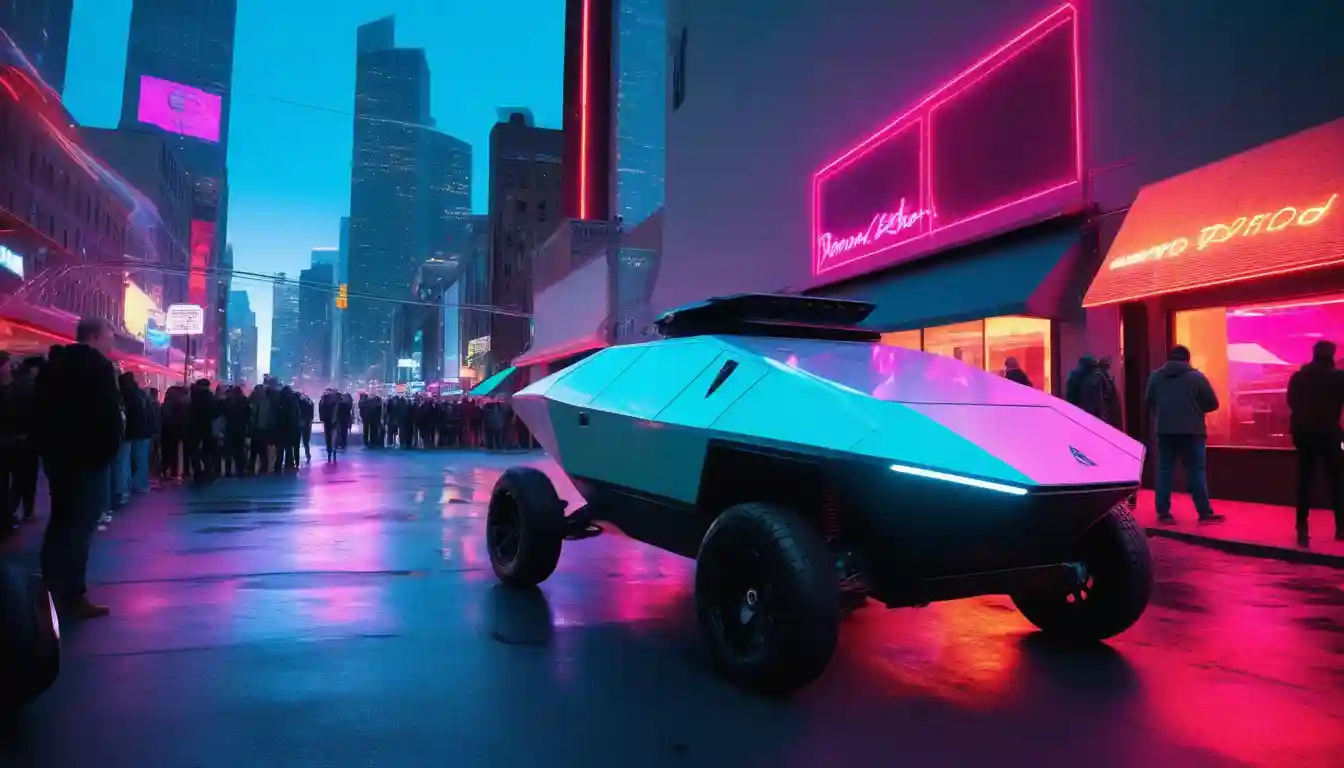
Tesla Forces $15000 Tech Package on Premium Cybertruck Buyers Despite Sliding Sales
Tesla's Cybertruck Gambit: When Premium Pricing Meets Market Reality
When bundling becomes burden: Inside Tesla's $15,000 bet on software monetization
AUSTIN, Texas — Tesla has quietly transformed its flagship Cyberbeast—the premium variant of its polarizing Cybertruck—into a $114,990 technological bundle that customers cannot unbundle. The mandatory "Luxe Package" represents a $15,000 price increase that forces buyers to purchase Tesla's Full Self-Driving software, unlimited Supercharging access, and four years of premium services whether they desire them or not.

This pricing maneuver arrives amid troubling sales data: Tesla delivered approximately 6,406 Cybertrucks in the first quarter of 2025, a figure that industry analysts describe as significantly below internal projections. The company's decision to raise prices on its struggling premium variant defies conventional automotive wisdom, where declining demand typically triggers incentives, not premium surcharges.
The Mathematics of Forced Value
Tesla's bundling strategy reveals sophisticated revenue engineering designed to extract maximum value from a shrinking customer base. The economics are stark: by mandating software and services that carry minimal marginal costs, Tesla potentially captures 70% of the $15,000 increment as gross profit.
"This represents a fundamental shift from selling cars to selling technological ecosystems," observed one investment analyst who requested anonymity due to client restrictions. "Tesla is essentially betting that forced software adoption will create higher lifetime customer value than volume sales."
The package components tell a revealing story. Full Self-Driving, priced at $8,000 separately, remains largely aspirational technology that many customers view skeptically. Free Supercharging, while attractive in principle, requires years of usage to justify its theoretical value. The four-year service package addresses Tesla's historically problematic service experience but forces customers to prepay for uncertain benefits.
Industry data suggests that fewer than 20% of Tesla customers previously opted for FSD when offered as an option. By making it mandatory on the Cyberbeast, Tesla achieves 100% software attach rates on its premium trim—a metric that significantly improves both immediate revenue recognition and deferred revenue accounting.
Market Positioning Under Pressure
The Cybertruck's commercial trajectory has deviated sharply from Tesla's initial projections. Early reservation numbers, once touted in the millions, have translated into modest quarterly deliveries that pale beside Ford's F-150 Lightning or Rivian's R1T performance.
Several industry specialists point to fundamental market dynamics working against Tesla's pricing strategy. The electric pickup segment has evolved rapidly, with competitors offering comparable capability at lower total cost without mandatory software bundles.
"Tesla built the Cybertruck for a market that existed in 2019," noted one automotive industry consultant who has worked extensively with electric vehicle manufacturers. "Today's buyers prioritize practical utility over technological novelty, especially at six-figure price points."
The timing compounds these challenges. With the federal EV tax credit capped at $80,000 MSRP for pickup trucks, the Cyberbeast's pricing eliminates any federal incentive eligibility—a significant barrier for price-sensitive buyers in an increasingly competitive segment.
Revenue Engineering Meets Consumer Resistance
Tesla's financial engineering reflects broader industry trends toward software monetization, but the execution carries substantial risks. By bundling disparate services into a single mandatory package, Tesla risks alienating customers who value choice and transparency in their purchasing decisions.
The company's accounting treatment of the Luxe Package will likely spread revenue recognition across multiple quarters through deferred revenue mechanisms, potentially smoothing financial results during periods of volatile delivery numbers. However, this approach creates future obligations that could pressure service margins if utilization exceeds projections.
Did you know? Deferred revenue—also called unearned revenue—is money a company collects upfront for goods or services it hasn’t delivered yet, so it’s recorded as a liability, not income, until the obligation is fulfilled. Think subscriptions, prepaid insurance, gift cards, or annual SaaS contracts: the cash arrives on day one, but revenue is recognized gradually as service is provided or at delivery. This boosts cash without immediately boosting earnings, offering a window into future revenue and obligations.
Free Supercharging, in particular, represents a complex liability. As Tesla's charging network approaches capacity constraints in many markets, unlimited usage rights could create operational challenges that the company's infrastructure may struggle to accommodate.
"Tesla is essentially selling future capacity it may not have," observed one energy sector analyst familiar with charging infrastructure economics. "If Cyberbeast owners become heavy Supercharger users, Tesla faces either network congestion or substantial capital expenditure requirements."
Strategic Implications for Tesla's Evolution
The Cybertruck bundling decision signals broader strategic tensions within Tesla's business model. The company must balance its historical growth-through-volume approach with emerging pressure to demonstrate software monetization capabilities that justify its premium market valuation.
Tesla's software and services revenue has become increasingly central to its financial narrative, particularly as automotive gross margins face pressure from increased competition and manufacturing scaling challenges. The mandatory Luxe Package represents an aggressive attempt to accelerate this transition, potentially at the expense of overall market share growth.
Did you know? Tesla’s revenue mix has been steadily diversifying: while automotive still dominates, its share has dropped from about 88% in 2022 to roughly 79% in 2024, as Services & Other expanded from around 7.5% to nearly 11% over the same period, helped by growing streams like Supercharging, paid service, used vehicles, and insurance; early 2025 filings show the shift continuing, with Services & Other reaching the mid-teens percentage in Q2.
The move also reflects Tesla's evolving market position. Where the company once disrupted established automotive economics through innovative manufacturing and direct sales, it now increasingly resembles traditional premium manufacturers that extract value through options and services rather than fundamental innovation.
Investment Calculus in an Uncertain Market
For investors analyzing Tesla's trajectory, the Cybertruck bundling strategy presents complex trade-offs between near-term revenue optimization and long-term market position. The immediate financial benefits appear substantial: higher average selling prices, improved gross margins, and enhanced deferred revenue metrics that could support quarterly earnings during delivery challenges.
However, the strategy's sustainability depends critically on factors beyond Tesla's immediate control. Interest rate movements could significantly impact affordability for luxury vehicle buyers. Competitive responses from Ford, Rivian, and emerging electric pickup manufacturers may further pressure Tesla's market position.
Most significantly, the strategy's success hinges on Full Self-Driving technology achieving meaningful capability improvements that justify its forced inclusion. Current FSD limitations mean Tesla is essentially charging customers for aspirational technology whose timeline for practical deployment remains uncertain.
Market analysts suggest monitoring several key metrics: Cybertruck registration data for demand trends, Supercharger network utilization rates for infrastructure stress, and Tesla's services margin progression as bundled obligations come due.
The company's decision to maintain unchanged pricing on lower Cybertruck trims suggests recognition that volume markets require different strategies than premium segments. This bifurcated approach may indicate Tesla's evolution toward traditional automotive market segmentation rather than its historically disruptive mass-market positioning.
The Road Forward
Tesla's Cybertruck bundling gambit represents a pivotal test of whether technological innovation can sustain premium pricing in increasingly commoditized electric vehicle markets. The strategy's immediate financial benefits appear clear, but its long-term implications for Tesla's market position remain uncertain.
Success will likely depend on factors beyond pricing strategy: FSD technology advancement, charging infrastructure scalability, and broader market acceptance of forced bundling in automotive contexts. Tesla's ability to execute this transition while maintaining customer satisfaction will significantly influence both its financial performance and competitive positioning in the rapidly evolving electric vehicle landscape.
For now, Tesla has chosen revenue optimization over market expansion—a decision that reflects both confidence in its technological differentiation and recognition of intensifying competitive pressures. Whether this approach proves strategically sound may well determine Tesla's trajectory in the post-growth phase of electric vehicle adoption.
NOT INVESTMENT ADVICE